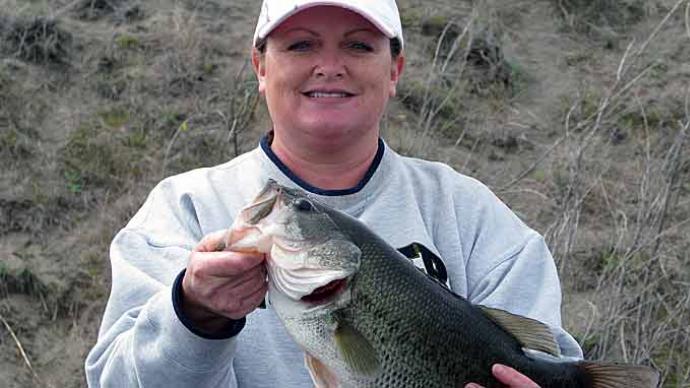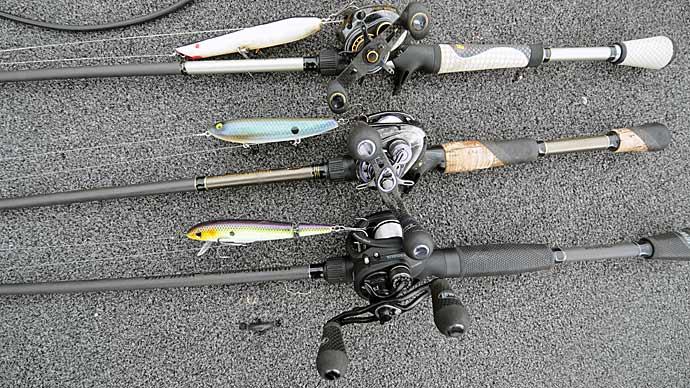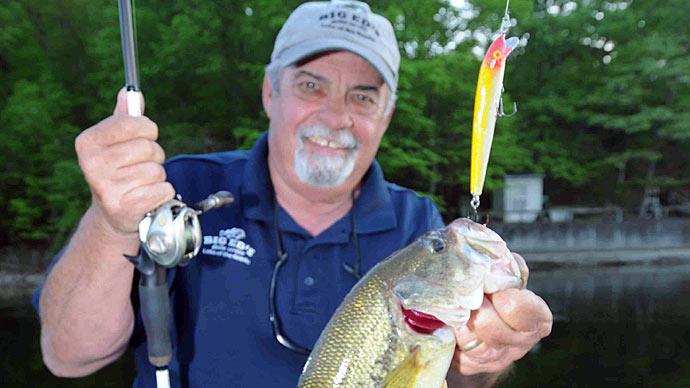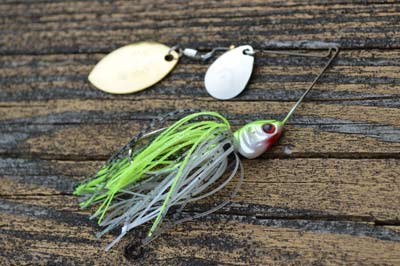
Spring brings plenty of good — warming temperatures, better weather, and consistent fishing. But there is some bad, too. Cold fronts, for example, put hot bass bites on ice. And spawning rigors make bass fickle. The latter often necessitates the use of soft-plastic lures. Their compact profiles and natural colors, textures, and actions give bass few, if any, reasons not to bite. But they aren’t your only choice. And many times, they aren't the best ones.
Hard baits excel in spring, from when bass first leave wintering holes until they make their way to deeper summer haunts. You can fish them fast, keeping up with bass that seem to be constantly moving. And they’re better at generating reaction strikes, something soft plastics struggle with when bass are in neutral or negative moods.
Finding the best hard baits for spring can be an arduous task, thanks to myriad choices of types, colors, sizes, and actions. But knowing where to start clears that confusion. The following five hard baits do just that. Tie them on, and you’ll be on your way to better spring fishing.
Spinnerbait
A tackle box staple for decades, this bladed option doesn’t see as much action as it once did. And that’s a shame. Packing plenty of versatility, it’s capable of catching bass from nearly every springtime situation.
Examples: Booyah Finesse Covert Series, Lunker Lure Hawg Caller, Berkley Power Blade
Sizes: ¼ ounce, 3/8 ounce, ½ ounce
Top colors: Baitfish, chartreuse and white, black
Spinnerbaits, which sport a weedless design, can be fished in nearly any amount of cover or depth of water, which are essential traits when chasing springtime bass. Wherever you send yours, reel it just fast enough so you can barely see it. Bass cling to that edge of light penetration, hidden enough to ambush prey.
Getting the most from a spinnerbait requires creating the perfect combination of weight, blade, and skirt color for the situation at hand. While skirt color can be handled independently — dark colors in stained or muddy water and natural or bright hues in clear water — weight and blades must cooperate. For example, if you're fishing deep water for prespawn bass, you'll want a heavy head and small blades; more weight and less lift keeps your lure in that strike zone.
Choosing blade shape and color is straightforward, too. Willow blades, for example, are best for clear water, where you want plenty of flash and less water resistance so you can tow your spinnerbait quickly. Colorado-style blades, on the other hand, are better for stained and muddy water. They put out plenty of vibration but require a slower retrieve. Silver and gold blades are universal, though copper can work well in stained or muddy water. Painted blades can help in muddy water but are also effective for smallmouth swimming in clear water.
You can’t fish a spinnerbait wrong. One straight from its package will produce bass. But there are ways to make them better. Here are three:
- Tow a trailer hook: Spinning blades and pulsating skirt attract bass but don’t provide a precise target. Some bass will simply swipe at it. Catch more of them by adding a free-swinging trailer hook.
- Add a soft-plastic trailer: These bring action to your spinnerbait, making it more appealing to bass. They also help it ride shallower, an important trait if you’re buzzing one right under the surface.
- Experiment with retrieves: Some bass will react to a straight retrieve most days. But you’ll catch more by changing it up — injecting periodic pauses or enacting a pull-and-drop cadence.
What makes a great spinnerbait?
Vibration is a crucial characteristic of spinnerbait. While its blades create it, its wire frame amplifies it. Most spinnerbaits are built with .045 wire, but you’re better off with thinner stock such as the .032 wire used in Hawg Caller spinnerbaits. Thin wire lacks some durability, but catching more bass make up for it.
Jerkbait
This classic springtime lure creates an erratic action that’s irresistible to bass, regardless of their mood. It works at spring's start when water temperatures are coolest, and at its conclusion, when they’re warmest.
- Examples: Original Rapala, Smithwick Rattlin’ Rogue, Megabass Vision 110
- Size: 4 inches to 4½ inches
- Top colors: Silver sides with blue or black back, gold with black back, translucent baitfish patterns
Catching more bass on a jerkabit requires fine-tuning your retrieve cadence — the combination of twitches and pauses. Twitches draw in bass, and pauses allow them to strike. When bass are active — warm water and low-light conditions — few if any pauses are needed. But they’re vital when conditions swing to the other end of the spectrum. You’ll need to find a balance between most days.
Windblown primary or secondary points or a flat covered with submerged aquatic vegetation in the back of a bay are two of the best places to fish jerkbaits. But don’t dawdle. Use their speed to keep up with bass.
Today's most popular jerkbaits are constructed of plastic and slowly float or suspend at rest. But make room for a few traditional balsa floaters like the Original Rapala. While they can be worked like any traditional jerkbait, they excel in late spring, especially for shallow largemouth. Work them across the surface using quick twitches of your rod tip and long pauses, allowing them to float motionless on the surface.
There are other ways to make your jerkbait fishing more productive. Here are three:
- Use a thin line: Spool up with 8- or 10-pound test fluorocarbon or monofilament line. They’re less visible in clear water, where jerkbaits work best, and allow your lure to gain greater depth.
- Add freedom: Give your jerkbait room to create its trademark bass-attracting action. Instead of synching your knot against its eye, add a split ring, loop knot, or snap between line and lure.
- Adjust the float rate: Depending on conditions, bass may want a jerkbait that slowly floats or suspends when paused. Make your floating jerkbait do either by adding weight in the form of heavy wire hooks, lead tape along the body, or lead wire around hook shanks.
What makes a great jerkbait?
A jerkbait's calling card is its erratic action. Its dips, dives, and dead stops are what trip a bass's trigger. The best ones deliver all those while tracking true toward you. Avoid ones that wander to one side or fail to gain depth. They’ll catch some bass but not as many as one whose path is predictable.
Square-Bill Crankbait
Image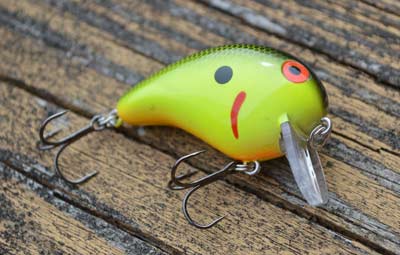
Square-bill crankbaits are at home in shallow water filled with heavy cover. You’ll get the most bites by banging them into every piece of cover that you can find. Photo by Pete M. Anderson When the water is shallow, and the cover is thick, these hard throbbing crankbaits are irresistible to bass. But you can’t be afraid of snags. They work best when repeatedly bounced off pieces of hard cover.
- Examples: Black Label Cliff Pace Wreck, Bomber Shallow A, Strike King KVD 1.5
- Size: 2 inches to 3 inches
- Top colors: Crawfish, shad, yellow with black back
A square-bill crankbait works in any shallow cover except aquatic vegetation. So, seek out laydowns, bushes, stumps, or other hard cover. Rocks, especially riprap, is one more important option. Springtime bass enjoy the heat it radiates into surrounding water. And it's an important substrate for spawning shad, which bass consider a delicacy, in late spring.
Fishing a square-bill crankbait is straightforward: Cast it out and collide it with cover. The only pauses you’ll add are immediately after each collision. Bass react to the impact and strike while your crankbait sits still, appearing stunned.
Your square-bill crankbait will require some finesse to navigate the thickest shallow-water cover. Unlike a rounded bill, which allows a crankbait to roll around cover it strikes, a square-bill can only hammer through it. So, throw it some slack after each contact by pushing your rod's tip toward it during the pause. That'll allow it to float up and then swim over. Here are three more things to make your square-bill fishing better:
- Plan your casting angles. Make the most of each retrieve by lining up as many pieces of cover as possible. The fewer pieces of cover, the shorter your casts should be.
- Carry a lure retriever: You’ll need one to free your favorite square-bill from the inevitable snags. And consider rigging up two. If one snags on a piece of prime cover, continue fishing with the second one. Once you’re done, you won’t worry about ruining the spot while you free the first.
- Experiment with retrieve speed: Match your square-bill's speed to the conditions. For example, fishing in stained or muddy water requires a slower retrieval than fishing in clear water.
What makes a great square-bill?
You’ll catch the most bass with one that creates a tight wiggle and strong vibrations, so fish ones whose bill is nearly vertical. It also needs to track straight, ensuring you find fewer snags and create more predictable retrieves. So, take time to tune yours if need be by slightly bending its eye in the opposite direction it runs.
Lipless Crankbait
These lures cover plenty of water, whether with a straight or drop-and-fall retrieve. Their size perfectly matches prey, and they create plenty of noise, forcing bass into reaction strikes.
- Examples: Booyah One Knocker, Bill Lewis Rat-L-Trap, Cotton Cordell Super Spot
- Size: ¼ ounce to ½ ounce
- Top colors: Chartreuse crawfish, red crawfish, baitfish
Lipless crankbaits cover more water in less time than any other hard bait. You'll still be on the move even if your retrieve is filled with pauses. And that's important in spring when bass move toward shallow water to spawn, then back to deep water for summer.
Use your lipless crankbait as a search tool, fan casting flats and points. Key on available structure, such as a creek channel or ledge, and cover such as submerged bushes or aquatic vegetation. And they don’t have to be in deep water. Ripping a lipless crankbait across a shallow flat with the rod tip held high has caught piles of late prespawn bass.
One detail that anglers seem to miss is color. Your lipless crankbait is moving quickly and making plenty of noise, so bass aren't as picky about its color. A good rule of thumb is that the more stained the water or smallmouth you're chasing, the brighter the color. Here are two more tweaks to try:
- Different retrieves: A straight one works most of the time, but it takes time to experiment. Sometimes, using your rod tip to pull your crankbait and letting it sink as you collect slack line produces better results.
- Low-stretch line: Braided line and reaction baits usually don't mix. But you'll want it here, especially fishing aquatic vegetation. A simple pop of your rod’s tip will free your lure and increase the chance of a strike.
What makes a great lipless crankbait?
While you might think the best ones create the most noise, it's the hooks. Strikes happen fast. So, hooks with large gaps are important. They're more likely to grab a bass that swats at your lure or grabs it on the fall.
Poppers
Image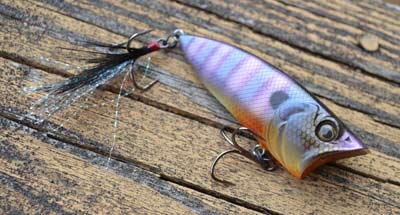
Spring marks the return of topwater fishing, and it’s best to start with poppers. Their small profile and skittering action are just what post-spawn bass want. Photo by Pete M. Anderson Topwater fishing can be hot even if the water temperature isn't. You can compensate for the lack of water temperature by fishing shallow water, creating a slow retrieve, and choosing a small lure.
- Examples: 6th Sense SplashBack 70, Don Iovino’s Splash-It, Rebel Pop-R
- Size: 2 inches to 3 inches
- Top colors: Baitfish, chartreuse
The ups and downs of spring fishing can make topwaters a gamble. But as spring progresses, the water warms, and cold fronts become less frequent, bass begin looking up for a meal. And once the water temperature eases into the 50s, it's game on for topwaters.
Every bass angler has a favorite topwater, but poppers are tough to beat in spring. They can be fished at any speed, from numbingly long pauses to rapid-fire twitches. You’ll have to experiment to find the best retrieve for the current conditions, but your effort will be rewarded.
Any piece of cover in water 5 feet or shallower is fair game for a popper. But emerging lily pads, boat docks, and riprap banks lead the list of options. Cast yours close to cover, and pay attention. Strikes can be subtle. Here are a few more things you can do to catch more and bigger bass on a popper:
- Try low-stretch line: Use 10—or 12-pound test monofilament, which floats, unlike fluorocarbon. This will ensure your rod tip twitches make it to the lure and your hook sets are sure.
- Choose a slow-action rod. Flexing nearly from handle to tip, it will serve two purposes. First, it will slow your reaction time, ensuring you set when the fish has your lure. Second, it provides enough cushion to keep a surging bass hooked on trebles.
- Add light wire hooks: Switching stock hooks for a size larger will help catch bass that simply swipe at your popper. With less mass, they won't impede its delicate action.
What makes a great popper?
To find the best poppers, take special note of their profile and face. Select a short and thin body to resemble a small springtime baitfish. It should have a flat face, which pushes water forward and allows it to skitter across the surface. Concave mouths catch water, forcing poppers underwater.
BassResource may receive a portion of revenues if you make a purchase using a link above.


